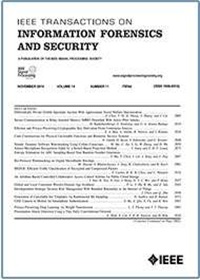RandFlash:打破大规模分布式随机信标的二次障碍
IF 6.3
1区 计算机科学
Q1 COMPUTER SCIENCE, THEORY & METHODS
IEEE Transactions on Information Forensics and Security
Pub Date : 2025-04-28
DOI:10.1109/TIFS.2025.3564877
引用次数: 0
摘要
随机信标在分布式系统(例如区块链、电子投票、治理)中至关重要。分布式环境中固有的节点的绝对规模需要最小化每个节点的通信开销,同时确保协议的可用性,特别是在对抗条件下。现有的解决方案已经设法将乐观开销降低到最小$O(n^{2})$,其中n表示系统的节点数。在本文中,我们进一步提出并实现了一种无领导随机信标协议RandFlash,该协议的乐观通信复杂度为$O(n\log n)$。评估结果表明,在包含64个节点或更多(例如,大小为80和128)的大型网络中生成的随机信标数量方面,RandFlash优于现有结构RandPiper (CCS ' 21)和OptRand (NDSS ' 23)。此外,RandFlash显示出弹性,能够承受多达三分之一的节点恶意行为,所有这些都不需要强信任设置(即由受信任的第三方嵌入秘密陷阱门)。我们还提供正式的安全证明,验证此沿袭所支持的所有属性。本文章由计算机程序翻译,如有差异,请以英文原文为准。
RandFlash: Breaking the Quadratic Barrier in Large-Scale Distributed Randomness Beacons
Random beacons are of paramount importance in distributed systems (e.g., blockchain, electronic voting, governance). The sheer scale of nodes inherent in distributed environments necessitates minimizing communication overhead per node while ensuring protocol availability, particularly under adversarial conditions. Existing solutions have managed to reduce the optimistic overhead to a minimum of $O(n^{2})$ , where n represents the node count of the system. In this paper, we step further by proposing and implementing RandFlash, a leaderless random beacon protocol that achieves an optimistic communication complexity of $O(n\log n)$ . Evaluation results demonstrate that RandFlash outperforms existing constructions, RandPiper (CCS’21) and OptRand (NDSS’23), in terms of the number of random beacons generated within large-scale networks comprising 64 nodes or more (e.g., in sizes of 80 and 128). Furthermore, RandFlash exhibits resilience, capable of withstanding up to one-third of the nodes acting maliciously, all without the need for strongly trusted setups (i.e., embedding a secret trapdoor by trusted third parties). We also provide formal security proofs validating all properties upheld by this lineage.
求助全文
通过发布文献求助,成功后即可免费获取论文全文。
去求助
来源期刊

IEEE Transactions on Information Forensics and Security
工程技术-工程:电子与电气
CiteScore
14.40
自引率
7.40%
发文量
234
审稿时长
6.5 months
期刊介绍:
The IEEE Transactions on Information Forensics and Security covers the sciences, technologies, and applications relating to information forensics, information security, biometrics, surveillance and systems applications that incorporate these features
 求助内容:
求助内容: 应助结果提醒方式:
应助结果提醒方式:


